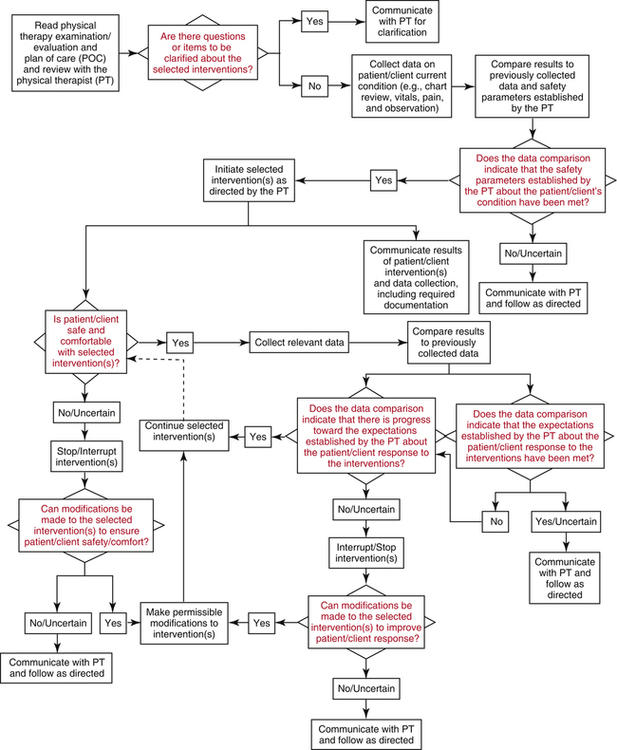1
Patient Supervision and Observation During Treatment
1. Discuss the “Problem-Solving Algorithm Utilized by PTAs in Patient/Client Intervention.”
2. Identify and discuss the rationale for clear and concise communication among all members of the rehabilitation team.
3. Discuss the skills necessary to provide patient supervision.
4. Define objective scales of measurement used to communicate changes in a patient’s status to the supervising physical therapist.
5. Apply proactive listening skills and objective scales of measurement to provide appropriate, accountable, and responsible observation and supervision of the patient during treatment.
6. Define open-ended and closed-ended questioning.
7. Define the quadrants of the basic dimensional model.
8. Discuss the four categories of behavior of the physical therapist assistant: dominance, submission, hostility, and warmth.
SUPERVISING THE PATIENT DURING TREATMENT
The PTA is responsible for carrying out prescribed selected interventions, patient supervision, data collection, and appropriate problem solving and clinical decision making. The American Physical Therapy Association’s Department of Education, Accreditation, and Practice developed the “Problem-Solving Algorithm Utilized by PTAs in Patient/Client Intervention,”1 which reflects current policies and positions on the problem-solving processes to be utilized by PTAs in the provision of selected interventions (Fig. 1-1). For proper care to be given, the PTA must monitor the patient’s response to selected interventions and accurately and swiftly report changes to the supervising PT. This involves constant patient interaction, observation, data collection, reassessment of initial data, problem solving, and responsive action to clarify and enhance the effectiveness of prescribed selected interventions. Changes in the patient’s status, both positive and negative, can occur throughout the treatment program, whether during a single visit or over the span of multiple treatments. Some of these changes are subtle and require keen awareness of the initial objective data and acute sensitivity to the patient’s subjective reports. Other changes are profound and sudden. In either situation, the PTA observes the patient and collects appropriate data, such as range of motion, strength, pain, balance, coordination, swelling, endurance, or gait deviations. When reported to the supervising PT, these changes dictate and can significantly affect the course of treatment.
Components of Patient Supervision
Clinical patient supervision can be viewed as a process with the following purposes:
 To gather relevant information and data
To gather relevant information and data
 To establish and enhance rapport, trust, and confidence
To establish and enhance rapport, trust, and confidence
 To facilitate understanding of the PTA’s concept of the patient’s problem as outlined, described, and initially determined by the supervising PT
To facilitate understanding of the PTA’s concept of the patient’s problem as outlined, described, and initially determined by the supervising PT
 To assist in the management of the patient
To assist in the management of the patient
 To provide a conduit or therapeutic outlet for the patient to voice concerns about his or her problem
To provide a conduit or therapeutic outlet for the patient to voice concerns about his or her problem
While providing selected interventions, the PTA makes observations of the patient, collects relevant data, and develops an objective assessment using appropriate scales of measurement (Box 1-1). Using applicable questioning techniques ensures that the patient is actively involved. This interactive approach to supervision, as well as the skills of the PTA to seek, understand, and accurately relay information related to the patient’s status distinguishes the PTA from an on-the-job trained aide.5
Patient Supervision by the Rehabilitation Team
The PTA must be aware of the key members of the rehabilitation team. The PT and PTA are involved with direct patient care on a daily basis and may be assisted by supportive personal, such as physical therapy aides or technicians. The occupational therapist and occupational therapy assistant, along with the speech language pathologist, audiologist, rehabilitation counselor, nurse, respiratory therapist, psychologist, and dietitian, play significant roles in daily patient care. These rehabilitation specialists seek to maximize recovery for each patient and always must be regarded as resources to meet specific patient needs as they are identified by any member of the team. Thus the PTA charged with direct patient care and supervision is only one vital member of the team, and he or she can take comfort in knowing that every member of the team is prepared to provide appropriate skills so that the patient can achieve the highest functional gains in recovery. Developing a team mindset helps the PTA to be responsible and accountable to the other members of the team for his or her own contribution and to reach out to others when their expertise is needed.7
Stay updated, free articles. Join our Telegram channel

Full access? Get Clinical Tree







